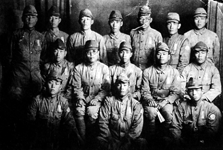
(1943-1998)
 |
Photo Exhibit (1943-1998) |
Please click photographs. to view the related
pages.

This photo was taken in July,1943.
This was of the training division in Pusan.
All the Korean recruits were teenagers.
In this division, day in and day out,
they slapped the face of each other,
and learned melee skills with a bayonet
and "Imperial Mandate For Soldiers".
They had to suppress themselves
and blindly obey their superior.
In effect they learned a cult mentality.
This is of the Korean recruits
after two months of training.
From the arm band, one could see
that they were allowed to go out.
Right hand side in the first row is Mun Jae-haeng,
one of the plaintiffs.
His possession was confisticated
when he got arrested.
But a few photos, including this photo
which he sent to his family, survived.
The Allied Prisoners Of War
were forced to perform hard physical labor.
This drawing is of an Allied prisoner
who died of cholera.
The fatality rate for the Allied POW
captured by the Japanese was seven times higher
than those by the Nazi Germans.
Even now some of the former POW
suffer from latent syndrome.
They say Japanese were more cruel
than Nazi Germans.
Japan was defeated, and Korea liberated.
The Korean prison guards thought
that they could simply go back to Korea.
They left the Japanese forces.
While waiting for the ship bound for Korea,
they lived together.
They now openly spoke Korean
and the Korean flag was flying in their community.
Yet soon after the end of war
the Allied soldiers came to their community
and started to arrest the Koreans for war crimes.
Cho Mun-sang.
His Japanese name was Morisune Hirahara.
He was executed in February 1947
and was only 26 years old.
Because he was an interpreter,
he became the butt of prisoner's hatred.
In the death row, until right before his execution,
he kept writing a long note.
"Friends, brothers, have your own ideas.
I am now facing my own death and realize
that I have no idea of my own."
This remark expresses his remorse:
he was a devout Christian
but had to live as a collaborator
of the imperial Japanese.
Changi Prison In Singapore.
War crime suspects, as well as convicted Japanese,
Koreans and Taiwanese,stayed here.
For those who were given death sentence,
they stayed in the P-hall until the day of execution.
On the specially-built scaffold,
more than 124 people got killed.
In addition, because of violence, torture, deprivation
and forced labor by the Allied soldiers
--the steps that they took to revenge the ill treatment
inflicted by the Japanese forces in prison camps--
some people died without trial or verdict.
This rag is the towel that Kim Wan-geun,
one of the plaintiffs, used during his prison term.
"L508" was his number in the prison.
This was kept carefully
and presented as evidence in one of the proceeding.
They are the war criminals who are about to be
transferred
from the Autorum prison to Japan.
In this picture, there are not only the Korean plaintiffs
and their comrades but also Mr. Abe Hiroshi
who was to be the first ex-Japanese officer
to testify in the trial of war compensation issues.
Two Korean BC class war criminals
who were just released stands before the Sugamo prison.
Their clothes and shoes were borrowed,
and bags was made of cardboard.
He did not have anything.
From the day that he got out, he had to struggle for his life.
Due to hard life,
two of the ex-Korean BC class war criminals
committed suicide.
Their fellow Korean war criminals
went to the Prime Minister's residence,
demanding livelihood assistance
and later individual compensation.
The government replied
that they would come up with some positive resolutions;
it never fulfilled this promise.
After Japan-Korea Normalization Treaty in 1965,
the government stopped taking their demand seriously.
Its reply was always,
"everything was resolved in the treaty."
For the past forty years,
the ex-Korean BC class war criminals have insisted
that the Japanese government is responsible for the burden
that they were forced to carry.
It ignored each time.
When they realized
that there was no way to change the government,
they decided to bring the case to the court.
Although they knew that they could not win,
they could not let their suffering be forgotten.
In trial, they can leave
as official documents everything that they say,
every document that they submit
and every remark that Defendant Japanese government makes.
They knew that this was their last chance,
considering that every year they lose
some of their comrades by death.
In September 1997, seven years after the trial
started,
they were given the verdict.
It rejected their demand.
The court said that ex-Korean BC class war criminals
should put up with any war-related damage just like Japanese.
It did not mention the fact
that they were forced to become Japanese.
As for filing the suit at the high court, they were reluctant.
They were weak and old and did not have much money left.
Yet for the last hope they decided to appeal.
Ex-Korean BC Class War Criminals vs. Japan
is currently in the Tokyo High Court.
Mr. Mun Tae-bok,
the head of the society of Koreans (Doushinkai)
and of the plaintiffs, passed away on February 2, 1998.
He has led the movement for such a long time
and died a few days before the final hearing
at the high court. He was 74 years-old.
On the right hand side, there is Mr. Lee Hak-lae and his wife.
What is Mr. Lee saying
to his deceased friend in his silence?
![]() Return to HOME
Return to HOME